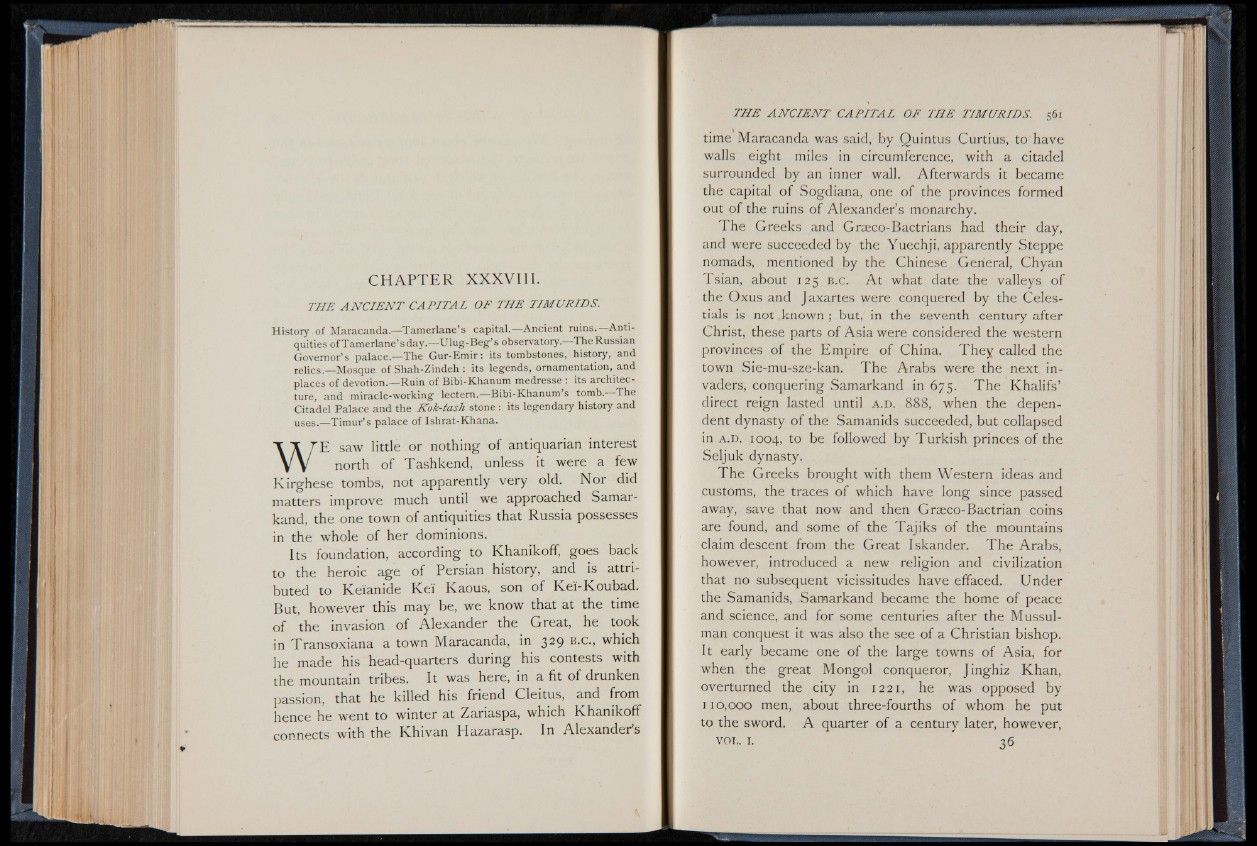
C H A P T E R X X X V I I I .
TH E A N C IE N T C A P IT A L O F TH E TIM URID S.
History of Maracanda.— Tamerlane’ s capital.— Ancient ruins. Antiquities
of Tamerlane’ s day.— Ulu g-B eg’ s observatory. The Russian
Governor’ s palace.— The Gur-Emir: its tombstones, history, and
relics.— Mosque of Shah-Zindeh : its legends, ornamentation, and
places of devotion.— Ruin of Bibi-K h a n um medresse • its architecture,
and miracle-working lectern.— Bibi-Khanum s tomb. The
Citadel Palace and the Kok-tash stone : its legendary history and
uses.— Timur’ s palace of Ishrat-Khana.
WE saw little or nothing of antiquarian interest
north of Tashkend, unless it were a few
Kirghese tombs, not apparently very old. Nor did
matters improve much until we approached Samarkand,
the one town of antiquities that Russia possesses
in the whole of her dominions.
Its foundation, according to Khanikoff, goes back
to the heroic age of Persian history, and is attributed
to Keianide Kei Kaous, son of Kei-Koubad.
But, however this may be, we know that at the time
o f the invasion of Alexander the Great, he took
jn Transoxiana a town Maracanda, in 3^9 ®-C-> which
he made his head-quarters during his contests with
the mountain tribes. It was here, in a fit of drunken
passion, that he killed his friend Cleitus, and from
hence he went to winter at Zariaspa, which Khanikoff
connects with the Khivan Hazarasp. In Alexander’s
time Maracanda was said, by Quintus Curtius, to have
walls eight miles in circumference, with a citadel
surrounded by an inner wall. Afterwards it became
the capital of Sogdiana, one of the provinces formed
out of the ruins of Alexander’s monarchy.
The Greeks and Graeco-Bactrians had their day,
and were succeeded by the Yuechji, apparently Steppe
nomads, mentioned by the Chinese General, Chyan
Tsian, about 125 B.C. A t what date the valleys of
the Oxus and Jaxartes were conquered by the Celestials
is not known ; but, in the seventh century after
Christ, these parts of Asia were considered the western
provinces of the Empire of China. They called the
town Sie-mu-sze-kan. The Arabs were the next invaders,
conquering Samarkand in 675. The Khalifs’
direct reign lasted until a .d . 8 8 8 , when the dependent
dynasty of the Samanids succeeded, but collapsed
in a .d . 1004, to be followed by Turkish princes o f the
Seljuk dynasty.
The Greeks brought with them Western ideas and
customs, the traces of which have long since passed
away, save that now and then Graeco-Bactrian coins
are found, and some of the Tajiks of the mountains
claim descent from the Great Iskander. The Arabs,
however, introduced a new religion and civilization
that no subsequent vicissitudes have effaced. Under
the Samanids, Samarkand became the home of peace
and science, and for some centuries after the Mussulman
conquest it was also the see of a Christian bishop.
It early became one of the large towns of Asia, for
when the great Mongol conqueror, Jinghiz Khan,
overturned the city in 1221, he was opposed by
110,000 men, about three-fourths of whom he put
to the sword. A quarter of a century later, however,
VOT.. I. 36